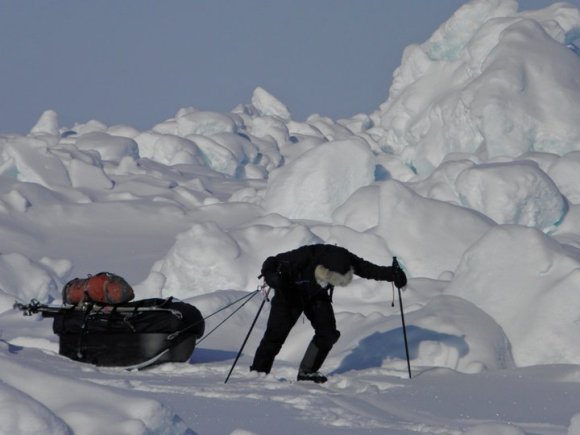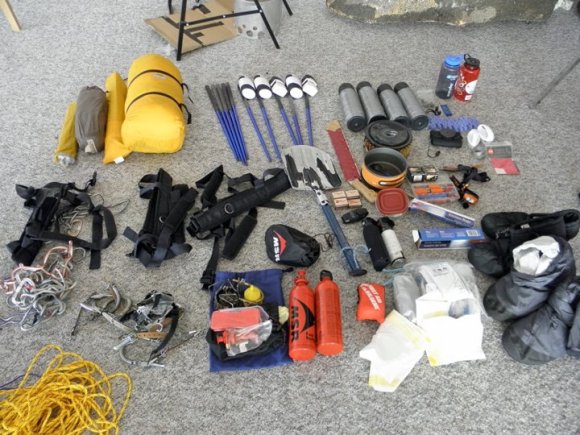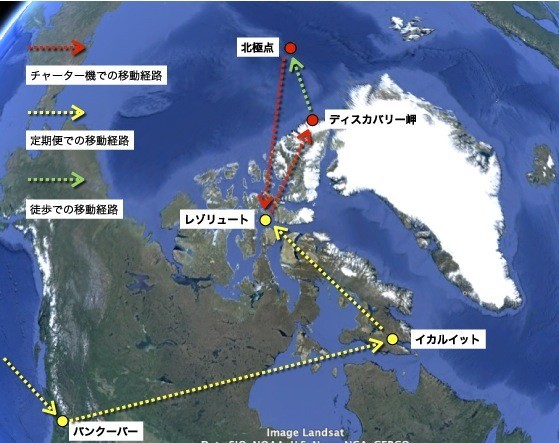
Do your eyes light up with excitement at the prospect of exploring remote land untouched by humankind? Even if your idea of adventure is a new brand of cup ramen, we think everyone can be impressed by Japanese explorer Yasunaga Ogita, who will make a second attempt at a gruelling solo trek to the North Pole. And the nearly 800-km journey will be made all the more difficult since Ogita plans to hike through some of the world’s coldest and harshest terrain without any supplies other than what he alone can carry.
Reaching the North Pole without aid
In 2014, Ogita will face a challenge that only two other people in the world have ever accomplished. Starting from the northernmost part of Canada in one of the most remote parts of the arctic territory of Nunavut, he will attempt to cover the 800 km distance to the North Pole in about 50 days. Ogita will travel along on the top of the world and will not have any access to supplies other than what he has packed himself. If he succeeds, he will be the first Japanese person to have completed the feat.
▼ The explorer speaking at a press conference about his upcoming challenge
Image: RocketNews24
A perilous journey made even more difficult
It goes without saying that reaching the North Pole on your own without backup is an extremely daunting challenge. Norwegian explorer Borge Ousland was reportedly the first to have done this in 1994, completing the trek in 52 days. The second person was British explorer Pen Hadow in 2003. Already a huge challenge, the recent climate change-fueled decrease in ice coverage will make the same expedition all the more dangerous.
Walking on sea ice
Since the North Pole has no land to speak of and is in the middle of the Arctic Sea, any trip there requires a good covering of sea ice. But as the earth is warming up, the melting ice sheets are getting thinner and creating an uncomfortably shaky trek. There are also fissures in the ice, called leads, that can cut off the main route to the North Pole. And when the ice sheets bump into one other, the ice can bunch up and cause mountain-like patches of ice, making the normally flat path very rocky.
▼A picture from Ogita’s past adventures near the North Pole showing the rough ice
Image: Facebook (ogita.exp)
These cracks and rough patches of ices are very hard to predict and when explorers come across these cracks in the ice, they only have two choices: swim across through frigid waters or find a detour. When Ogita attempted this challenge for the first time in 2012, he came across a lead so wide that he was forced to abandon his entire trek.
100 kg of supplies, 5,000 calories per day
Ogita’s only company on the expedition will be the 100 kg of supplies he will be carrying when he starts. There will not be any opportunities for resupplying, so he will have to carefully plan to make sure he is carrying just the right amount.
▼Some of the contents of Ogita’s pack from a past trek to the North Pole
Image: Facebook (ogita.exp)
For the strenuous trek, Ogita is planning to consume about 5,000 calories per day. But even eating over twice the amount of calories an average male needs won’t prevent him from losing about 10 kg (22 lbs). When preparing his pack, he will have to delicately balance the weight of the food and the possibility of going hungry.
▼ Ogita’s food supply for a past adventure to the North Pole–mostly CalorieMate blocks!
Image: Facebook (ogita.exp)
20 encounters with a polar bear
In the past 12 times he has been in the Arctic Circle, Ogita has encountered polar bears around 20 times and even had his tent attacked twice. He often downplays the dangers when talking to the public, but this he faces a huge number of extremely dangerous situations.
500 km away from humanity
Ogita will be completely alone during the entirety of his 50-day trek to the North Pole with only the rare chance to talk to anyone through radio communications. He has told reporters that he expects to be able to endure the loneliness since he signed up for the challenge. But the real issue for Ogita is the fact that should he require any help, the nearest human will be 500 km away. In 2007 while on an expedition, he sustained serious burns on his hands when his tent caught on fire, but luckily he was with other explorers.
▼ A map showing Ogita’s travels. From Japan, he will fly to Vancouver and eventually make his way to Iqaluit, the territorial capital of Nunavut. From there, he will take another flight to the farther north Resolute Bay where he will take a chartered flight to Cape Discovery—the starting point for his solo trek. After reaching the North Pole, he will be flown back to Resolute Bay.
Image: North Pole Adventure
Can he do it?
Ogita will start his training in February and begin the solo trek in March. If all goes as scheduled, he should reach his goal on April 20 and then be flown back to civilization. He will then become the first Japanese, and the third person ever, to have walked to the top of the world alone and without backup.
Would you be up for this kind of adventure or are you happy to cheer on Ogita from the sidelines? Take a look at two videos of Ogita’s past expeditions and let us know if you are up for the challenge of an arctic trek!
▼A look at Ogita’s attempt in 2012
▼Ogita encounters a polar bear
Videos: YouTube (ogitaexp)
[ Read in Japanese ]





 J.J. Abrams sits down for an interview with RocketNews24 about Star Trek, the moviemaking process
J.J. Abrams sits down for an interview with RocketNews24 about Star Trek, the moviemaking process Japanese man travels 100 kilometres (62 miles) from Tokyo to Hakone on stilts
Japanese man travels 100 kilometres (62 miles) from Tokyo to Hakone on stilts Japan’s JAXA wants to build a fuel processing plant on the surface of the moon
Japan’s JAXA wants to build a fuel processing plant on the surface of the moon Mr. Sato channels his inner Elsa, books a night at a Hokkaido ice hotel 【Photos】
Mr. Sato channels his inner Elsa, books a night at a Hokkaido ice hotel 【Photos】 Creator of Japan’s first pole dancing manga talks with our pole-dancing reporter【Interview】
Creator of Japan’s first pole dancing manga talks with our pole-dancing reporter【Interview】 Red light district sushi restaurant in Tokyo shows us just how wrong we were about it
Red light district sushi restaurant in Tokyo shows us just how wrong we were about it Japanese ramen restaurants under pressure from new yen banknotes
Japanese ramen restaurants under pressure from new yen banknotes McDonald’s new Happy Meals offer up cute and practical Sanrio lifestyle goods
McDonald’s new Happy Meals offer up cute and practical Sanrio lifestyle goods French Fries Bread in Tokyo’s Shibuya becomes a hit on social media
French Fries Bread in Tokyo’s Shibuya becomes a hit on social media Pokémon Sleep camping suite and guestrooms coming to Tokyo Hyatt along with giant Snorlax burgers
Pokémon Sleep camping suite and guestrooms coming to Tokyo Hyatt along with giant Snorlax burgers Sandwiches fit for a sumo served up in Osaka【Taste Test】
Sandwiches fit for a sumo served up in Osaka【Taste Test】 Tokyo Tsukiji fish market site to be redeveloped with 50,000-seat stadium, hotel, shopping center
Tokyo Tsukiji fish market site to be redeveloped with 50,000-seat stadium, hotel, shopping center Starbucks Japan adds a Motto Frappuccino to the menu for a limited time
Starbucks Japan adds a Motto Frappuccino to the menu for a limited time Akihabara pop-up shop sells goods made by Japanese prison inmates
Akihabara pop-up shop sells goods made by Japanese prison inmates Mt. Koya planning to instate visitor’s tax to cope with huge tourist numbers
Mt. Koya planning to instate visitor’s tax to cope with huge tourist numbers All-you-can-drink Starbucks and amazing views part of Tokyo’s new 170 meter-high sky lounge
All-you-can-drink Starbucks and amazing views part of Tokyo’s new 170 meter-high sky lounge More foreign tourists than ever before in history visited Japan last month
More foreign tourists than ever before in history visited Japan last month Studio Ghibli releases new action figures featuring Nausicaä of the Valley of the Wind characters
Studio Ghibli releases new action figures featuring Nausicaä of the Valley of the Wind characters New private rooms on Tokaido Shinkansen change the way we travel from Tokyo to Kyoto
New private rooms on Tokaido Shinkansen change the way we travel from Tokyo to Kyoto Starbucks reopens at Shibuya Scramble Crossing with new look and design concept
Starbucks reopens at Shibuya Scramble Crossing with new look and design concept Studio Ghibli glasses cases let anime characters keep an eye on your spectacles
Studio Ghibli glasses cases let anime characters keep an eye on your spectacles Beautiful Ghibli sealing wax kits let you create accessories and elegant letter decorations【Pics】
Beautiful Ghibli sealing wax kits let you create accessories and elegant letter decorations【Pics】 Studio Ghibli releases Kiki’s Delivery Service chocolate cake pouches in Japan
Studio Ghibli releases Kiki’s Delivery Service chocolate cake pouches in Japan New definition of “Japanese whiskey” goes into effect to prevent fakes from fooling overseas buyers
New definition of “Japanese whiskey” goes into effect to prevent fakes from fooling overseas buyers Our Japanese reporter visits Costco in the U.S., finds super American and very Japanese things
Our Japanese reporter visits Costco in the U.S., finds super American and very Japanese things Studio Ghibli unveils Mother’s Day gift set that captures the love in My Neighbour Totoro
Studio Ghibli unveils Mother’s Day gift set that captures the love in My Neighbour Totoro New Japanese KitKat flavour stars Sanrio characters, including Hello Kitty
New Japanese KitKat flavour stars Sanrio characters, including Hello Kitty New Pokémon cakes let you eat your way through Pikachu and all the Eevee evolutions
New Pokémon cakes let you eat your way through Pikachu and all the Eevee evolutions Disney princesses get official manga makeovers for Manga Princess Cafe opening in Tokyo
Disney princesses get official manga makeovers for Manga Princess Cafe opening in Tokyo Sales of Japan’s most convenient train ticket/shopping payment cards suspended indefinitely
Sales of Japan’s most convenient train ticket/shopping payment cards suspended indefinitely Sold-out Studio Ghibli desktop humidifiers are back so Totoro can help you through the dry season
Sold-out Studio Ghibli desktop humidifiers are back so Totoro can help you through the dry season Japanese government to make first change to romanization spelling rules since the 1950s
Japanese government to make first change to romanization spelling rules since the 1950s Ghibli founders Toshio Suzuki and Hayao Miyazaki contribute to Japanese whisky Totoro label design
Ghibli founders Toshio Suzuki and Hayao Miyazaki contribute to Japanese whisky Totoro label design Doraemon found buried at sea as scene from 1993 anime becomes real life【Photos】
Doraemon found buried at sea as scene from 1993 anime becomes real life【Photos】 Tokyo’s most famous Starbucks is closed
Tokyo’s most famous Starbucks is closed One Piece characters’ nationalities revealed, but fans have mixed opinions
One Piece characters’ nationalities revealed, but fans have mixed opinions We asked a Uniqlo employee what four things we should buy and their suggestions didn’t disappoint
We asked a Uniqlo employee what four things we should buy and their suggestions didn’t disappoint Princesses, fruits, and blacksmiths: Study reveals the 30 most unusual family names in Japan
Princesses, fruits, and blacksmiths: Study reveals the 30 most unusual family names in Japan What’s it like to pole dance on a rooftop in Tokyo?
What’s it like to pole dance on a rooftop in Tokyo? Mr. Sato attempts to conquer mountains of shaved ice at all-you-can-eat event
Mr. Sato attempts to conquer mountains of shaved ice at all-you-can-eat event Cheeky seal gets sled ride at Japanese zoo, decides he’s pretty much done with walking 【Video】
Cheeky seal gets sled ride at Japanese zoo, decides he’s pretty much done with walking 【Video】 We built a steel rack taller than our crazy cheap country Japanese house with Daiso goods
We built a steel rack taller than our crazy cheap country Japanese house with Daiso goods Defector: Gaming culture is alive and well in North Korea, popular titles include GTA V and FIFA
Defector: Gaming culture is alive and well in North Korea, popular titles include GTA V and FIFA South Korean shoppers literally leap off walls for free The North Face goods
South Korean shoppers literally leap off walls for free The North Face goods Seoul Cafe’s mint chocolate shaved ice is unlike any other shaved ice around【Photos】
Seoul Cafe’s mint chocolate shaved ice is unlike any other shaved ice around【Photos】 Japanese man goes missing at sea for 20 hours, then gets rescued by a lucky lifebelt
Japanese man goes missing at sea for 20 hours, then gets rescued by a lucky lifebelt San’in, Japan is breathtakingly beautiful especially when captured with a 4K video camera【Video】
San’in, Japan is breathtakingly beautiful especially when captured with a 4K video camera【Video】 Kim Jong-un’s “little red book” of quotes is the worst joke book you can buy for 500 yen
Kim Jong-un’s “little red book” of quotes is the worst joke book you can buy for 500 yen North Korea shows military prowess by bludgeoning a wide range of ceramics【Video】
North Korea shows military prowess by bludgeoning a wide range of ceramics【Video】 We attempt to conquer the 7-hour all-you-can-eat yakiniku deal at Yakiniku Like
We attempt to conquer the 7-hour all-you-can-eat yakiniku deal at Yakiniku Like Excessive dog pee to blame for traffic light collapse, Japanese police think
Excessive dog pee to blame for traffic light collapse, Japanese police think North Korea bars foreign tourists to prevent spread of Ebola
North Korea bars foreign tourists to prevent spread of Ebola 8 ways Kim Jong-Un has blindsided the US
8 ways Kim Jong-Un has blindsided the US Hike from the sea to the peak of Mt. Fuji with new bilingual English/Japanese guide map series
Hike from the sea to the peak of Mt. Fuji with new bilingual English/Japanese guide map series
Leave a Reply